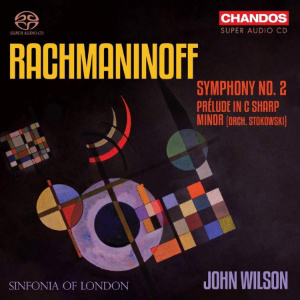
Sergei Rachmaninoff (1873-1943)
Prélude, Op. 3 No. 2 in C sharp minor from ‘Morceaux de fantaisie’ (1892, orch. Stokowski)
Symphony No. 2, Op. 27 in E minor (1906-07)
Sinfonia of London/John Wilson
rec. 2022, Church of St Augustine, Kilburn, London
Chandos CHSA5309 SACD [64]
I began listening to classical music whilst at university in the early 1970s. I recall Gramophone’s Edward Greenfield ecstatically receiving André Previn’s EMI recording of Rachmaninoff’s E minor symphony. At that point I was familiar with the second and third piano concertos and not much else, so I borrowed a library LP of another recording, Kletzki’s on Decca, I think.
Amazingly, it took me some time to decide that I liked the piece. At this remove I cannot understand why I needed several weeks to warm to it. But once the slow movement had worked its way into my consciousness, I became a firm fan. When my financial situation improved after getting my first job, I bought the Previn LP. For many years, the symphony was my favourite orchestral work by Rachmaninoff. My tastes have gradually changed over the years. Now I warm more to the composer’s later style, although I retain a great fondness for all his music.
The first thing I noticed about the disc was the spelling of the composer’s surname, ending with ‘off’ rather than the usual ‘ov’. The former is how he signed his name in the USA, so that may be why Chandos chose it. I think that American concert programs use it as well.
Stokowski’s orchestration of the famous Prelude in C sharp minor, which begins the programme, very effective starts with hugely glowering brass and timpani. When the strings entered, I had to pick up the booklet to check the performance. For a few seconds I could have sworn that I heard very Russian-sounding high voices rather than strings. Repeated playing confirmed this effect. It may not be worth my making much of it, but it is most atmospheric.
After this four-minute appetiser, I was prepared to revel in the symphony, but gradually became rather disappointed. The performance is just 30 seconds faster than Previn’s, hardly significant in an hour-long symphony. At times, Wilson belongs to the laid-back school of performance, certainly in the finale, but I acknowledge that he rises to the climax of the slow movement in a most effectively unrestrained manner. I think the main problem with the performance is not just an occasional impression of lack of intensity, but the recessed nature of the sound, which makes the violins sound anything but opulent. A direct comparison with the fifty-year-old EMI Kingsway Hall recording reveals the LSO strings to have a significantly fuller presence. The overall sound, whilst possibly less sophisticated than this newcomer, makes greater effect. I prefer Jack Brymer’s subtle account of the incredible clarinet melody in the slow movement to that of the unnamed artist of the Sinfonia of London, fine though they are.
Some people react to Rachmaninoff’s music by wanting the lusciousness tamed. Personally, I am all for drive and fire where appropriate, but there I have no doubt that the string saturated textures of this symphony demand a fair degree of succulence – rather more than here. This rather surprised me, because the latest Wilson/Chandos SACD I reviewed – the English Music for Strings collection – had the sort of string sound that one only rarely encounters.
A couple of years ago, I picked up a second-hand copy of Temirkanov’s 1977 RPO recording on EMI. I was impressed by the forward momentum that he brings to the piece, at nearly four minutes less than Previn’s timing. The RPO is not recorded with the same fullness of string tone that Previn was afforded, but there is no doubt that the performance has great fire and effect, without sounding rushed.
Jim Westhead
Previous review: Ralph Moore (March 2023)
Help us financially by purchasing from





















